Friends and fans call lesbian freestyle poet Tiffany Scales the “Wordmatician” for how she manipulates words like a mathematician manipulates numbers and formulas. I watched her perform at a black box theater in downtown Houston a few weeks after Hurricane Harvey devastated the city and displaced thousands of Texans, including Scales. She had lost everything in her apartment. Like many LGBT Houstonians, Scales has been forced to find innovative ways to heal and recover after Hurricane Harvey. Her chosen way is this — her art.
“What art does for me in this space,” she begins, pausing, searching, then finally settling on: “This is why I get out of bed.”
As we chat backstage after the performance, Scales hugs friends as they approach and calls them baby and darling. An attendee tells Scales her performance was beautiful and says he’ll add her on Facebook.
“I don’t think there’s a prescription that could be sufficient to the healing than art does,” she adds.
Scales is part of The T.R.U.T.H. Project, an organization dedicated to empowering and educating LGBTQ communities of color and their allies through performance art. I met her after “Strength: After the Rain,” a spoken word, dance, visual art and music show benefiting T.R.U.T.H. Project Members impacted by Hurricane Harvey. T.R.U.T.H. CEO Kevin Anderson hoped the show would “begin healing” for the artists and community both.
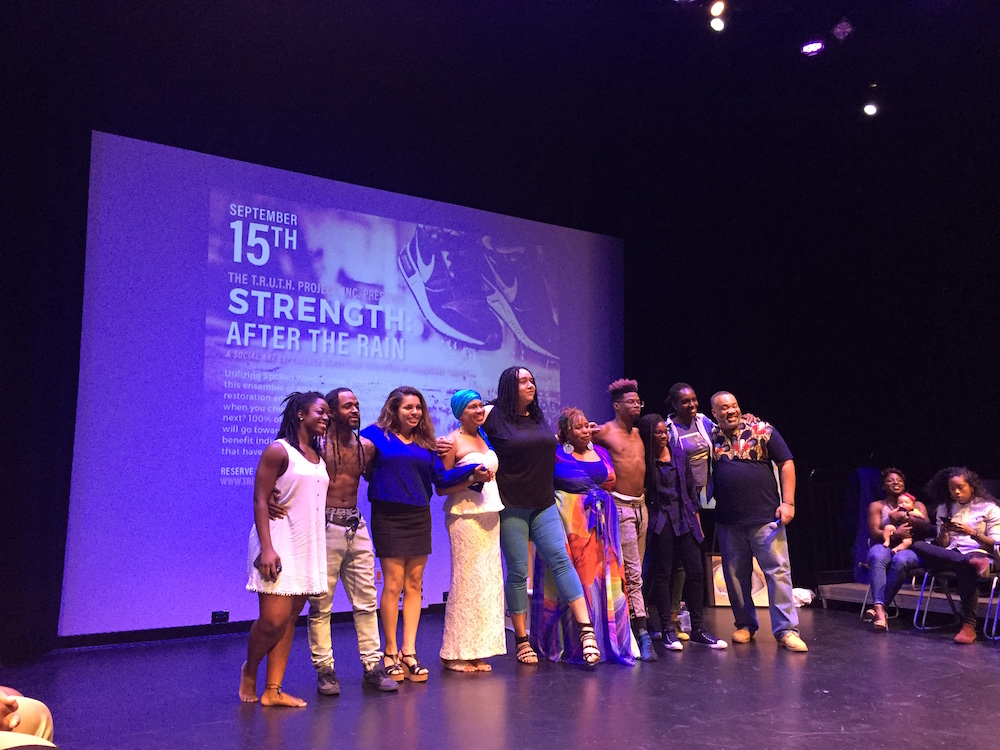
The T.R.U.T.H Project artist lineup. Photo by Yvonne Marquez
The T.R.U.T.H. Project lineup consisted of all artists of color and almost all Houston natives. They included dancers Lathasia Collins, Loren Holmes, Damion Sam and Cedric Hicks; Mexican-American poet Cristina Martinez and award-winning poet Marie Brown; singer Rechatter Brady and artist Abiola Wabara who painted live on the stage during the show. The black box theater at the Midtown Arts and Theater Center was an intimate setting for the almost 70 people (mostly people of color) who attended the show.
The Weather Channel called Hurricane Harvey a “truly historic hurricane.” It dumped record-breaking rainfall in Southeast Texas, making landfall on Aug. 25 as a Category 4 storm near Rockport, Texas, and eventually weakening into a tropical storm that circled over Southeastern Texas until Aug. 30. 19 trillion gallons of water fell along the Gulf Coast, enough to cover the entire states of Alaska, California and Texas with an inch of water.
“Meteorologically, southeast Texas, at the time, was pretty much a giant stop sign,” Jonathan Belles, a meteorologist with Weather.com told the Houston Chronicle. “There were two high pressure systems that wouldn’t let Harvey move in any direction. So for three or four days, Harvey pretty much sat there and dumped rain.” What made Harvey a unique storm was that it was stalled out with part of its body hanging out on the coast and the other part on land, which meant it “acted like a conveyer bell pulling water out,” Bernhard Rappenglueck, a professor of atmospheric science at the University of Houston told the Houston Chronicle.
The Houston area specifically saw upwards of 50 inches of rainfall, reaching Houston’s annual rain average of 49.77 inches in just a few days. Thousands were forced to evacuate, and many were rescued by the Texas National Guard, the U.S. Coast Guard, Houston Police, Harris County Sheriff’s Department, and even private citizens on boats. AccuWeather estimates that Harvey caused $190 billion in damages including disruptions to businesses, increased rates of unemployment, damage to infrastructure, crop losses, property damage and higher fuel prices.
Scales has lived in Houston for 21 years and has witnessed two of the Gulf Coast’s worst hurricanes — Hurricane Rita in 2005 and Hurricane Ike in 2008. After Hurricane Katrina devastated New Orleans a few weeks earlier, anxiety over Rita, potentially a Category 5 hurricane, inspired Houston-area residents to evacuate en masse, thus causing the city’s worst-ever traffic jam. Scales sat on Highway 290 for eight hours before giving up and returning home to wait out the storm instead. Hurricane Rita eventually made landfall as a Category 3 and was responsible for $12 billion in total damages. Hurricane Ike was a Category 2, the third-costliest Atlantic hurricane ever, with a $37.6 billion price tag. Scales’ apartment at the time suffered water damages and she lost electricity for three weeks. Still, these experiences made her skeptical of evacuation and preparation measures recommended before Harvey.
Scales’ mother urged her to wait out the storm at her home in Sienna Plantation, a subdivision in Missouri City, southwest of Houston. Scales only packed a couple days worth of clothes thinking she’d be back soon. She ended up staying at her Mom’s for nearly a week, sleeping and waiting for the rain to stop and the floodwaters to recede.
On Thursday morning the roads cleared, and she returned to her job as a customer pickup coordinator at FedEx, planning to check on her one-bedroom apartment in Webster on her lunch break.
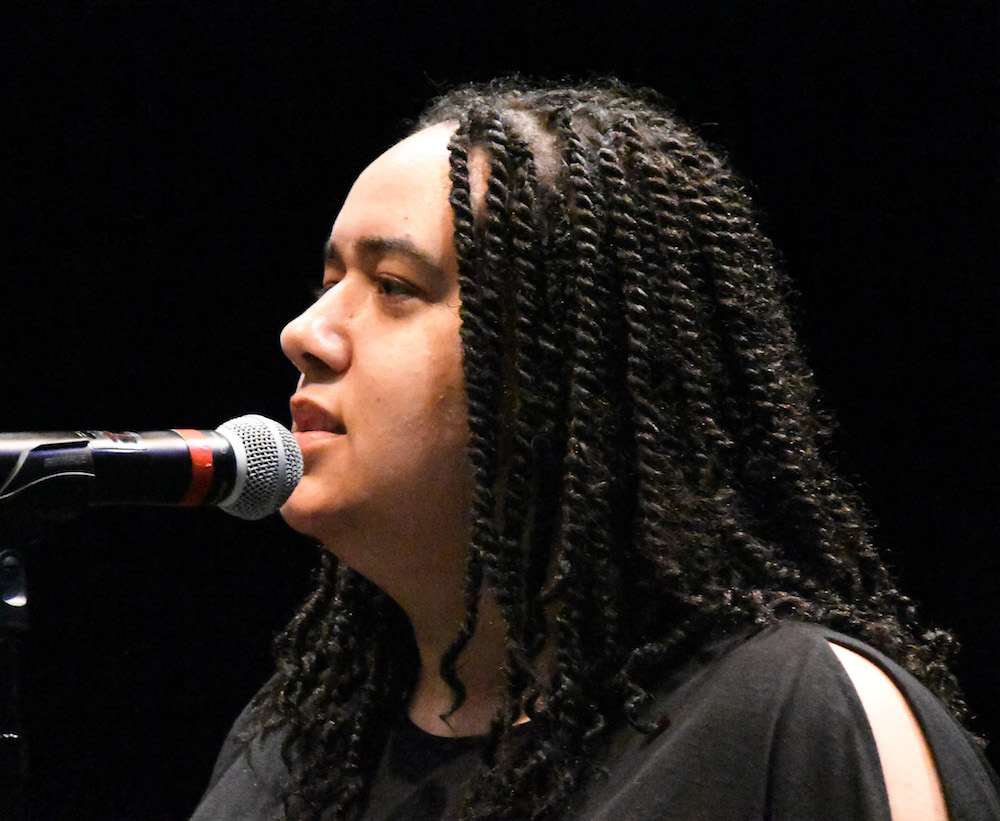
Tiffany Scales performing at “Strength After the Rain.” Photograph by Dalton DeHart.
When she did, she was met with a bleak and confusing scene. The curbs were littered with soggy couches, playpens, cribs, dressers and coffee tables, but there wasn’t any water in sight. While pulling into her designated parking spot in front of her unit, she noticed her windows were open and worried she’d been robbed. Later, she’d learn they’d been opened by apartment management without her permission, supposedly to prevent the smell of mildew.
Her first step into her first floor apartment was into a puddle of water. Everything was wet: furniture, photos, poems, journals, her shoes. The water lines on her walls marked the flood waters at a foot and a half.
Soon enough, the dehumidifiers provided by the apartment management to dry out her house would flood her house again — her apartment sink was too shallow for the water the dehumidifier’s hose was picking up. Despite her home being waterlogged, contaminated by the floodwaters, smelling like mold, and filled with dirt, she couldn’t completely clean it up until after her Federal Emergency Management Agency, FEMA, inspection. She didn’t want to risk being denied disaster assistance by making things look better than they were.
FEMA assistance generally helps cover rent for up to two months as well as some home repairs, which depends on exactly how much of your primary living space was damaged. Personal property like eyeglasses and dentures are sometimes covered, too. One person for each household applies online, on the phone or in person at designated recovery centers, supplying information on their household income and insurance information as well as describing the extent of damages. Once you apply, a FEMA inspector makes a visit, gets proof of ownership, and submits their report.
Scales says applying for FEMA assistance was stressful. “It’s so much red tape,” she says. “Some of the questions could be simplified. If you read something the wrong way, you throw your chances out of the window.”
The inspection, when it came two weeks after the storm, offered only bad news. The inspector told Scales to find another place to live because the apartment management could probably only afford “to paint over the mold.” In total, FEMA gave her $500 for immediate necessities. She used the funds to clean up her apartment and throw away debris. Luckily for Scales and other displaced employees, her employer, FedEx, provided them with temporary hotel accommodations. She lived at a La Quinta Inn and Suites for a month before moving into a short-term lease apartment.
For both the performers and the audience, the T.R.U.T.H. Project event was a much-needed space to process the aftermath of the traumatic event together. Unlike past performances, this one wasn’t meticulously planned or even rehearsed, it was meant to be organic and raw — for the emotions of the artists to dictate how the audience experienced the show. Anderson predicted the show would make the audience laugh and cry in equal measure. He was right. At one point he asked the audience to get up from our seats and we had a couple minutes to exchange handshakes or hugs with as many strangers we could. The room instantly brightened with smiling faces and lively chatter.
The stage was also ripe for processing, grieving and coming to terms with the aftermath of a natural disaster. Before the performance began, Anderson pointed out the mental health professional they’d brought in, telling the audience she was available for chats with any individual who needed to step out and talk during the show.
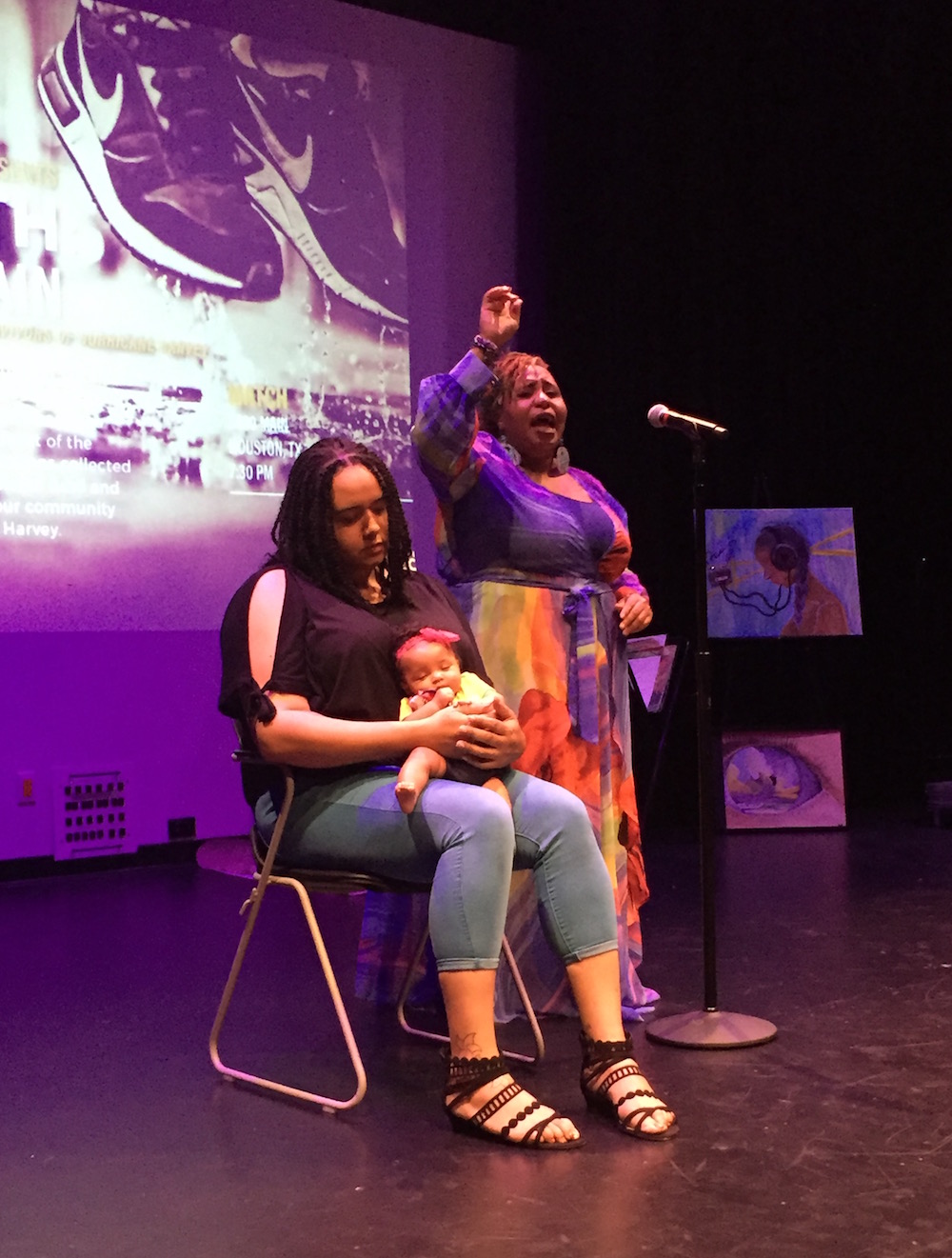
Kayenne Nebula performing and Tiffany Scales holding her 6-month-old goddaughter, Nova.
“What’s important to me with the T.R.U.T.H. project is how [Anderson] always makes sure that mental health is on the frontlines,” Scales said. “There’s always at least someone to talk to [at performances] because we do spark feelings and emotions and memories or things that have not been dealt with — even in ourselves, as the artists.”
Spoken word artist and New Orleans native Kayenne Nebula stepped to the mic in a long flowy dress with a watercolor-like print of an orange flower surrounded by swirling blues and yellows, and two large disc earrings reading “Wisdom is Wealth” on one side with a blue face on the other.
She asked Scales, a trusted friend, to sit beside her while she performed. Nebula recalled how Scales was the first person to encourage Nebula to perform at the T.R.U.T.H. Project and ensured her it was a safe space to share. Nebula wanted to draw strength from Scales in order to share a new piece about Hurricane Katrina. Scales sat in a chair, holding Scales’ 6-month-old goddaughter, Nova.
Nebula snapped the entire room into attention with her booming voice, singing, “Wade in the water, wade in the water…”, before launching into a poem recounting the injustices her community faced after Katrina, which for her included losing two family members. Her story eerily paralleled the experiences of Houstonians after Harvey.
Nebula was crying by the end of her performance, and when she returned to her seat, the other artists crowded around her, enveloping her in a big group hug.
It’s extra challenging for LGBT Houstonians to navigate and recover after a hurricane when organizations and government resources aren’t culturally competent or empathetic to LGBT people and issues, Alex Mackzum, a lesbian grant writer for Houston’s LGBT center, told me. After Hurricanes Katrina, Rita and Ike, the Montrose Center heard of cases where emergency and response services disregarded nontraditional family structures which led to queer families being separated during a rescue. They also heard of cases where queer and trans people were arrested at shelters for using facilities that matched their gender. Some were given clothes that didn’t match their gender identity, leaving them to remain in the dirty, wet clothes they’d came in. In other cases, response services aren’t aware of the medical necessity of HIV regimens or hormone therapy, often difficult to obtain during a natural disaster. Mackzum says that’s why the Montrose Center was quick to set up a LGBT disaster relief fund to allocate resources dedicated to their community’s recovery efforts.
“The center fills the gap between what it is already offered as a resource and the needs of the LGBTQ community because existing organizations and structures were built without consideration for that population.” Mackzum told me.
In the days and weeks following Harvey’s destruction, Montrose Center volunteers and employees got the ball rolling, providing inclusive direct response services to their community. The food pantry fed 257 individuals across 100 different households while case managers hit the phones to check in with their clients.
After the floodwaters receded, the Center had 20 teams of volunteers help clean and clear out community members’ homes — a huge undertaking for anyone or one family to do alone. When a home floods in a warm, humid climate like Houston, water-saturated walls and floors quickly develop mold, a noted health hazard. The water itself is contaminated by sewage and toxins that make people sick. So everything the water touches must go. There are carpets to rip out, sheetrock to remove, damaged furniture to move to the curb, important papers and photos to throw away. Then there’s the FEMA applications, private insurance claims and other disaster aid paperwork — the Center helps clients navigate that overwhelming project, too.
The Montrose Center is now focusing their efforts on long-term recovery. They raised about $750,000 for their disaster relief fund made possible by online donations and private foundations, which Mackzum says will all go toward helping LGBT Houstonians rebuild their homes, pay off insurance deductibles, repair cars and pay moving deposits. Families or individuals can apply for financial assistance for up to $1,000 with an option to apply for a larger sum based on needs. As of Oct. 18, they’ve had 480 online applications for disaster relief.
“We’re still rebuilding, even when we stop receiving news coverage,” Mackzum told me. “What we’re doing here is ensuring the long-term sustainability of a culture, a people, and a city.”
Among the most vulnerable populations affected by the hurricane were undocumented trans and queer people. Without proper identification, undocumented immigrants are not eligible for government assistance allocated for natural disaster victims. For example, FEMA requires a social security number, a checking account and insurance information from applicants, things an undocumented immigrant is unlikely to have, especially if they’re trans. Organización Latina de Trans en Texas (OLTT), a grassroots organization funded by the community and led by undocumented trans Latinas, are plowing forward to survive and taking care of their own after the storm.
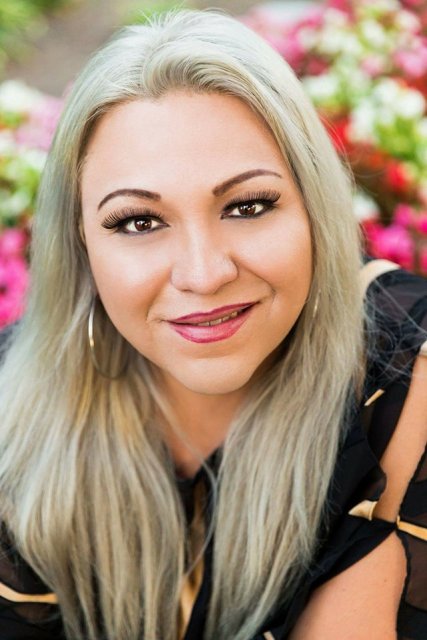
Ana Andrea Molina
Ana Andrea Molina, the undocumented trans Latina from Matamoros, Mexico who founded the organization, is a true chingona. (That’s Spanish for “badass.”) She created the organization following an incident at an event put on by a Latino organization that proclaimed it was pro-LGBTQ in January 2015, where attendees denied Molina and her friend’s female identities as well as access to the public women’s restroom.
Molina was livid, and quickly created a Facebook video talking about the incident, which inspired more trans friends to reach out with their own stories of similar experiences.
In March 2015, Molina set up a lunch meeting with a group of friends to discuss the situation and what they could do about it, and invited them to bring at least one or two other trans friends to join in.
Molina expected 15 or so participants. 50 undocumented trans women showed up.
Some had traveled from as far as two hours away, from surrounding areas in College Station and Bryan, Texas. The women described their experiences with discrimination, transphobia and racism. The meetings became monthly.
A year after their first meeting, their socially-organized group became an official nonprofit. They opened a small office in Houston with with two rooms, one for a couple of computers and another one for the receptionist desk. Molina says it was a very small space but the trans woman who came to their meetings didn’t mind. They would crowd in and even make themselves comfortable on the floor because it was the very first space dedicated to trans Latinas in Texas. “A lot of people told me I couldn’t do it,” she tells me in Spanish. Molina says not one single month’s rent was paid for by any other organization or government agency; it was all funded by their own community.
“We paid our own rent, our own bills, and our own activities,” Molina said. “We had our own food sales, monthly loterías, our own fundraisers, and much of this community help came from women who do sex work. How is it that the people who are the most stigmatized and marginalized, that when they organize, they’re the ones who help the most?”
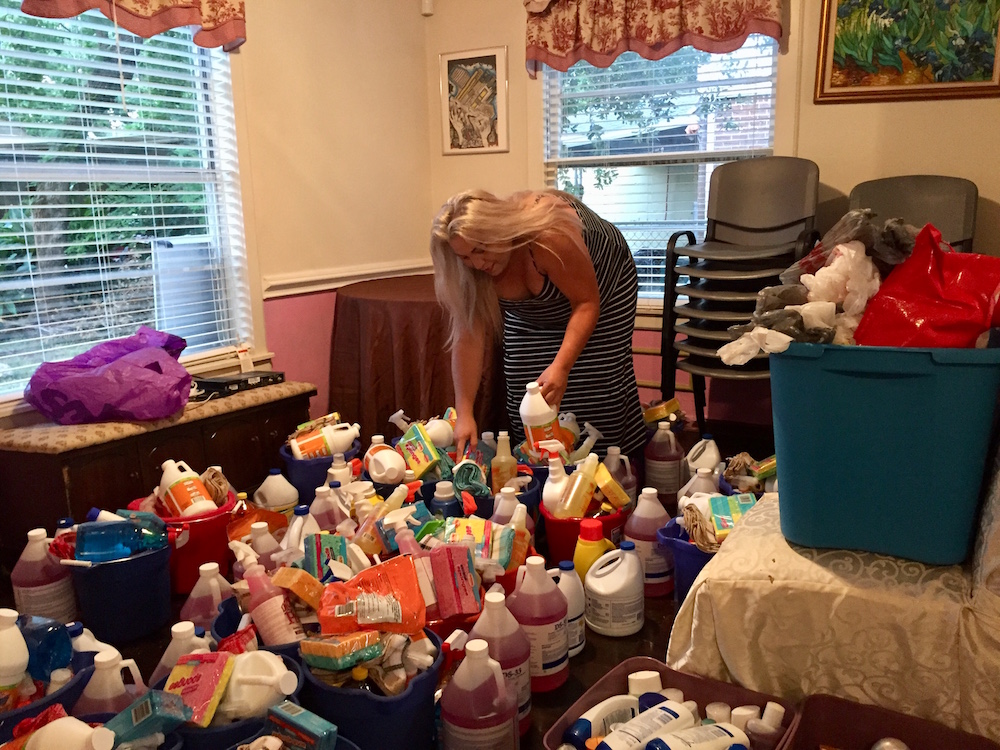
Ana Andrea Molina sorting out cleaning supplies, donations given to the organization.
At the start of 2017, OLTT hit rock bottom. They had $0 in their bank account and were forced to close the small space they’d worked so hard hard to maintain. But in March, Molina had a serendipitous encounter at the Texas capital, where she’d traveled to speak out against anti-immigrant and anti-trans bathroom bills introduced by the Texas legislature. Grey’s Anatomy star and out bisexual actress Sara Ramirez was there for the same reason, and the two women were introduced. Molina didn’t know who Ramirez was, assuming she was just another “privileged, cisgender woman who wanted to take her photo with a poor trans Latina.” Ramirez proved her wrong in the best way possible; after listening to Molina’s story and learning about her organization, Ramirez quietly gave $20,000 to OLTT, enabling them to re-open their office, expand their reach, and open a shelter for trans, queer and intersex people of color who are often turned away from other resources. There was no press fanfare. Ramirez just wanted to help.
Project Casa Ana Andrea began in May of this year, providing a unique space for programming dedicated to undocumented queer and trans people as well as beds for 15-20 people in need. Molina doesn’t receive a salary from the work she does for OLTT. She’s a beneficiary of her own non-profit, living there with five other trans women.
Molina was in San Francisco for a conference before Hurricane Harvey hit the Gulf Coast. The day she was supposed to fly back, the airport closed due to the incoming storm. She was stranded in California until the airport reopened days later. Fortunately, Casa Ana Andrea endured minimal loss aside from a leak in the roof that damaged their office computer.
But Molina knew she and the organization members were going to have to work twice as hard as usual to recuperate after a hurricane. Molina explained how Harvey left some of the members homeless. They lost their possessions, their only source of transportation, and two weeks of work. “For many of them, their families depend on them in Central America or Mexico or here,” Molina said.
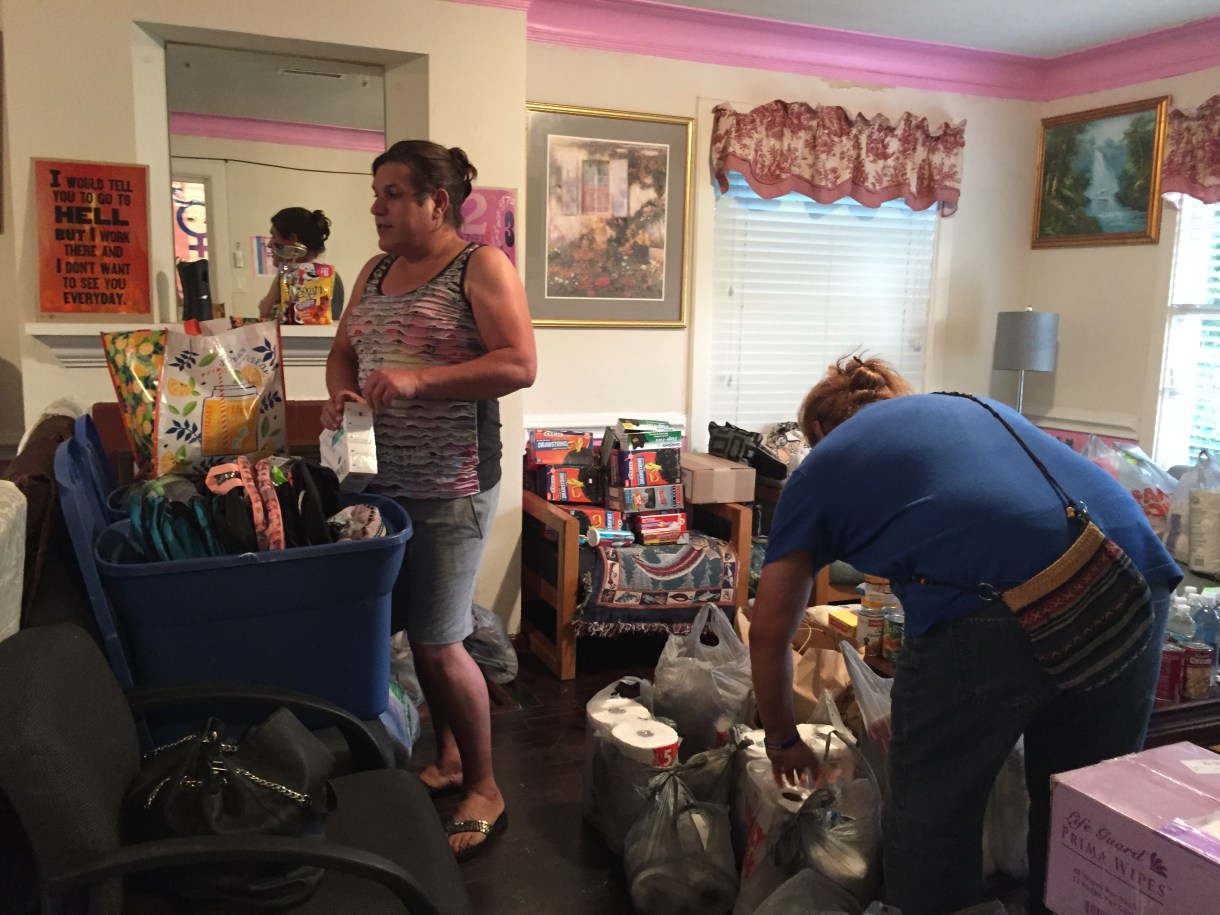
Anonymous members of OLTT separating donations at Casa Ana Andrea.
She explained that the hurricane had a domino effect on trans sex workers specifically. When male clients who patronize sex workers are also out of work and short on cash, sex workers are more likely to put their safety at risk — doing things like agreeing to sex without a condom — in order to get whatever work they can.
“A trans woman who does this kind of service needs the money so she risks it,” Molina said. “She needs to eat, she needs to live and she doesn’t qualify for a lot of resources that are offered.”
Casa Ana Andrea opened its doors to anybody affected by the storm, regardless of race or status, and distributed, at press time, at least 40 checks of between $100-$150 to members.
“It’s not a lot, but it is really significant,” she said. “Money is what we need. We need it to fix our cars, for gas to get to work and no one wants to help you with that and they want to help you less if you don’t have an ID.”
It’ll be hard for undocumented trans women to heal and recover after the storm, Molina says. What OLTT needs to move forward is resources. They need consultations from criminal and immigration lawyers and health care professionals. They need funds to continue their programming which includes deportation defense, LGBTQ education, assistance with name and gender marker changes, and help navigating the immigration system.
“For poor trans Latinas and black women, it’s difficult to heal a wound,” Molina said. “It’s difficult to get the resources to heal after a disaster, after Harvey. But what we’re going to do because our spirit is really strong, we’re going to let ourselves fall but when we get up, nothing can make us fall again.”
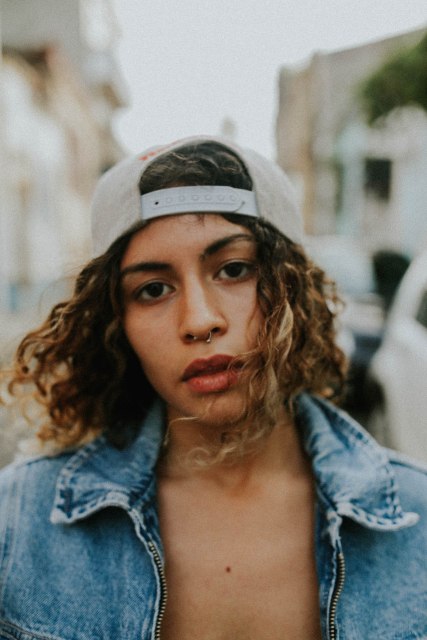
Jess Alvarenga
Queer Salvadoran photographer Jessica Alvarenga is just coming to terms and processing the aftermath of the storm. Her childhood home in the Larkwood subdivision in Southwest Houston was destroyed by Hurricane Harvey’s floods. Brays Bayou, which is located directly behind the home, overflowed, flooding the predominantly Mexican and Central American immigrant neighborhood. Alvarenga lived there with her parents until high school, when neighborhood gang violence drove them out. Still, her extended family maintained and lived in the property, and Alvarenga’s cousin, his partner and their five young sons between the ages of 6-12 lived in the home when Harvey touched down. Alvarenga was planning to move back in on Sept. 1st, but now there’s no place to move back in to. It’s uninhabitable.
Alvarenga is a self-taught documentary photographer and is working on a project called Witness the Isthmus, a series of photographs and oral narratives of Central American immigrants in their homes, places of worship and workplaces in Houston, TX. She hopes to capture a truer narrative of her community to counter anti-immigrant narratives spewed by conservative politicians who depict all Central American immigrants as members of the dangerous MS-13 gang.
“I wanted to shine a different light on Central Americans and show how they’re community members, how they’re showing out for their community and how they’re showing love,” Alvarenga said.
Alvarenga finds her subjects from her own network and community. She used to work at a labor union and kept in touch with several of the janitors she helped organize. She photographed one woman making tamales (which she sells to supplement her income) from start to finish in her home for eight hours, the typical amount of time she spends with her subjects. The woman loved the experience so she recommended Alvarenga to some friends. Alvarenga now has more than enough subjects to photograph.
“I don’t think anyone has ever asked them for their story,” Alvarenga says. “I don’t think anyone’s valued them. I don’t think anyone’s been like, hey you’re beautiful. You’re a work of art. Let me take your picture. I don’t think anyone’s done that, so subconsciously they’re really grateful for that.”
Now in light of Hurricane Harvey, she hopes to capture how Central American immigrants are moving forward after this tragedy.
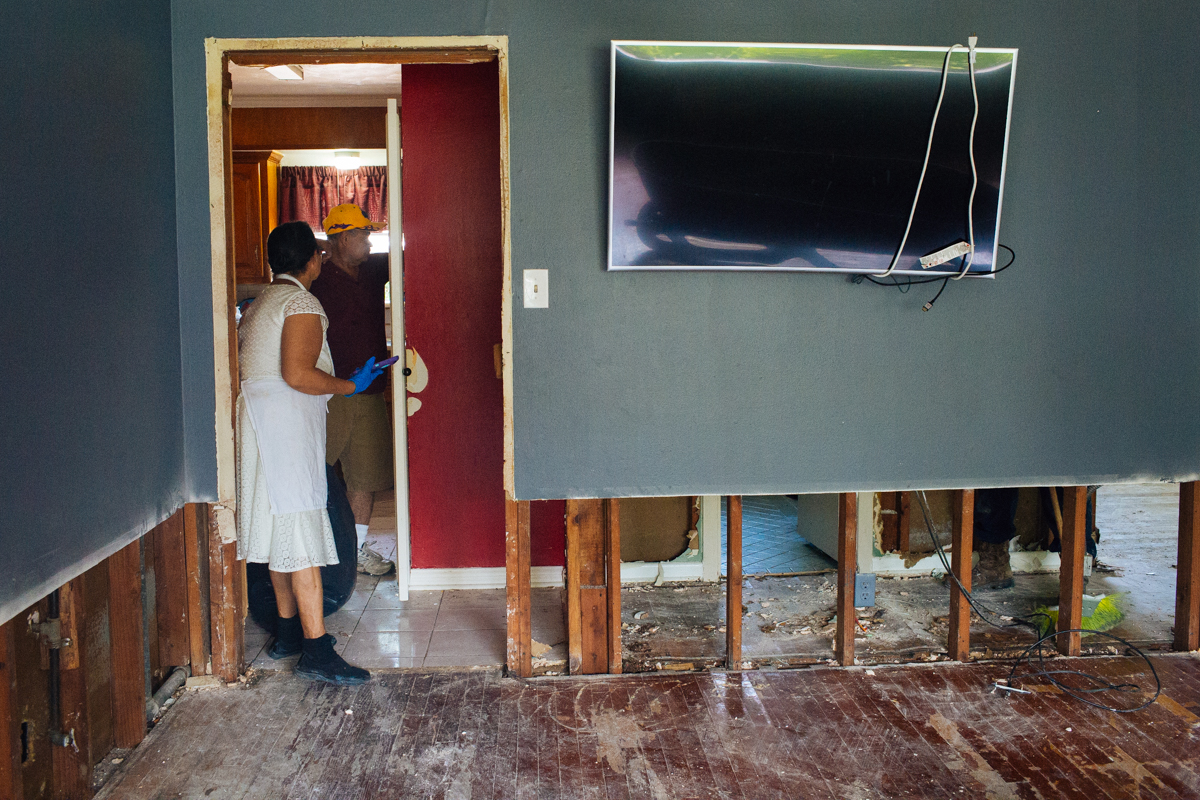
Alvarenga’s childhood home. Photograph by Jess Alvarenga
She photographed pastor Raul Hidalgo and his congregation at Emmanuel Baptist Church near downtown Houston. They’d converted their church into a temporary resource and donation center, open to everyone affected in the surrounding area. She tells me how appreciative the Central American immigrants she spoke with there were of that support.
“I ask them ‘how are you doing’ and todos me dicen, ‘blessed,’” Alvarenga says. “Everyone feels really grateful, even if they lost their home. They say, ‘I’m blessed. I still have my life, I still have my family.”
Alvarenga now lives with her parents in Cypress, TX. Her cousin and his family are living with Alvarenga’s aunt while they save money to fix the damaged home. For Alvarenga, a way to process the aftermath of the storm was to create new memories for herself and family. She photographed the cleanup of her childhood home. About 15 family, friends, coworkers helped tear up water-saturated floorboards and walls and removed debris and trash. She snapped a photo of her dad standing on top of the dresser Alvarenga had used as a little girl, which was now unusable and part of a pile of debris.
“Not only did we lose objects, we lost memories with the storm,” Alvarenga said.
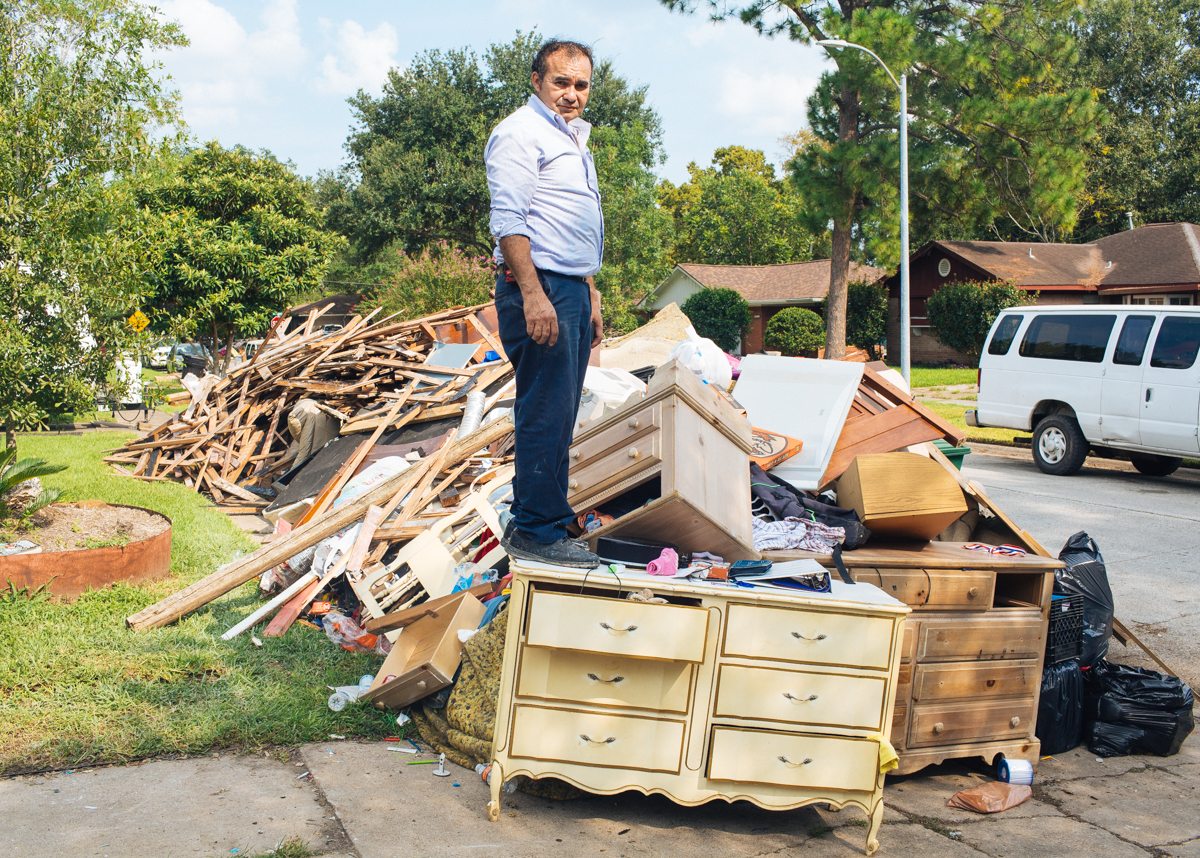
Alvarenga’s dad on her childhood dresser. Photograph by Jess Alvarenga.
Scales is trying to look at the good things that happen after a storm. She focuses on the love and the giving done by small organizations like her own Toiletries for Families who distributes hygiene items to individuals and families in need. She founded the organization in 2010 after Scales prayed for a purpose in life, starting off with a donation drive at one of her performances and soon surpassing her goal of distributing toiletry kits full of soap, shampoo, toothbrushes, toothpaste, deodorant and menstrual products to 12 families of four or more. She didn’t stop there and now her organization has distributed to 21,200 families since 2010. It’s all volunteer run and is supported by donations from the community and grants.
Before Scales left her apartment to wait out the storm, she made sure to put the 100 toiletry kits she had in stock on the top of a shelf. They were safe and dry when she returned.
“When I’m tired, even when I feel like my world has literally fallen apart or evaporated, I know that’s what I’m supposed to be doing,” she says. “The fact that I can go home and all of my hygiene kits are still good, you know it was just like this, keep doing it.”
The Red Cross donated three 53-foot trailers full of hygiene items, baby clothes, baby food and water to her organization that she continues to distribute all over the Gulf Coast with the help of volunteers. Now she’s shipping donations to Puerto Rico after Hurricane Maria. Scales calls her organization “her ministry” and says hygiene items can become difficult to obtain when people who can’t afford them but still need to be clean and presentable to hold a minimum wage job.
“We ask God or light or whatever word that isn’t offensive, how could you let this happen if you’re so good?,” she says. “But even in tragedy, after the storm, we have all of these beautiful things.”
Ana Andrea Molina’s quotes were translated from Spanish.



Yvonne – Houstonian here – thanks for doing this story! If anybody wants to donate to these places, like I was inspired to do after reading this, here are links so you don’t have to look them up!
http://www.latinatranstexas.org has a handy dandy donate button right at the top of the screen
https://www.montrosecenter.org/donate-online-2/give-now/
I couldn’t find anything for T.R.U.T.H. but if someone has a link that would be awesome
T.R.U.T.H. Project is here: http://www.truthprojecthtx.org
Love my city ❤️
Fantastic, personal and in-depth reporting Yvonne, thank you so much for this.
Incredible story incredible work incredible humans
This is really good, thank you for writing and sharing these important stories.
This interview is so compassionate and well done. Thanks for your diligence and willingness to hold their stories so tenderly.
This is very good reporting, thank you!
Thank you for writing this, Yvonne!
Thank you! This is so important
Thank you for sharing these stories!
Very heart warming stories here. The way these t/girls came together during this crisis is amazing.
yvonne this is amazing thanks so much for writing this for us!!!
<3
Late to the party, I’ve had this piece in an open tab on my browser waiting for when I had the time to sit down and really read it. Lovely article Yvonne, thanks for this!
This is incredible work, thank you!
This is a wonderful piece of writing, and the stories just warmed my heart. Thank you for sharing these with us.
So grateful for this post, read it a while back but returning to post cuz I want to say THANK YOU Yvonne and Scales and Molina and Alvarenga and Ramirez and all the people they work with.
How do we get this into consideration for a GLAAD award or some other journalism award??? Also if yall have any interest in sharing all these weeks of journalism work with progressive straights (totally understandable if not, but), seems like the kind of thing YES! Magazine would be into.
Thank you for sharing about T.R.U.T.H. and OLTT – I’m now convinced there are groups like this in so many places, we just have to look really hard because they are too busy doing the work to get the word out. Added these to a list to share with my giving circle for the future.
Finally made the time to read the whole thing and I have tears in my eyes. Thank you all.
thank you for this amazing piece.
This is awesome article, Thanks for writing stories here
BigLiving